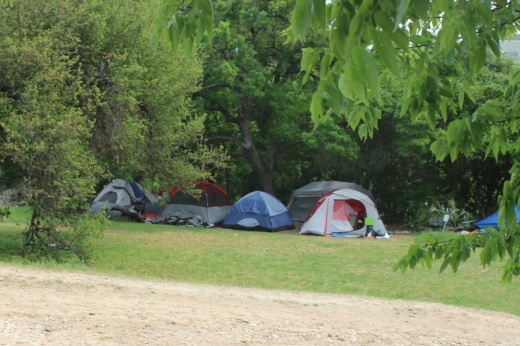The concept of opening designated encampments for those experiencing homelessness in Austin was most recently explored last summer in the wake of Proposition B's passage. More than 57% of city voters backed that measure in May 2021 to reinstate a previous ban on public camping as well as sitting, sleeping, lying down and "aggressive" panhandling. City leaders' broad push to build up homeless shelter and supportive housing systems has run alongside camping ban enforcement since then, and the city has struggled to keep pace with a growing need to manage campsites that are generally moving out of public view.
According to the most recent count from the regional homelessness leadership group Ending Community Homelessness Coalition, Austin-Travis County's homeless population grew 16.72% over less than one year after Proposition B passed. At the same time, city staff report a continued encampment presence citywide. City Council's budget planning for Austin's fiscal year 2022-23 included a review of funding and services for the city's unhoused residents, a discussion that prompted some renewed focus on officials' appetite for sanctioned encampments. Several council members in mid-August shared varying levels of concern or frustration with aspects of Austin's current homeless strategy as resident complaints on the issue continue to pour in and as millions more dollars are in line to be directed to related contracts and services over the next year.
“I don’t know anymore ... how we address the issues that are being raised because we get caught in this vortex, and it’s Groundhog Day every single time," Mayor Pro Tem Alison Alter said Aug. 11. "We’re talking about more resources and more resources. We need to get this to function better.”
Those sentiments in part led to the suggestion that it may be time to bring back formal planning for city-run campsites. Council closed the book on consideration of operating encampments on public land last July after city staff identified two possible finalists for such sites. At that time, Council Members Natasha Harper-Madison and Paige Ellis—whose districts were home to those locations—led the call for council to table its talks and instead consider "identified and proven" homelessness solutions. This month, District 9 Council Member Kathie Tovo said the widespread presence of unsanctioned encampments—now mainly concentrated around parks, highway underpasses and waterways—is a more risky and "unconscionable" situation than the alternative of city-managed sites.
"Until we have enough housing—which obviously should be our focus and should be our goal, that everybody in this city have access to a safe and stable house—until we get to that point, I really think that this city and this City Council needs to address setting up sanctioned camping areas so that those individuals on the street, our city staff who are interacting with individuals experiencing homelessness, have some place to tell them to go," Tovo said.
Council members Chito Vela and Mackenzie Kelly also shared interest in exploring the idea further. Vela said he continues to receive calls from constituents about camping-related issues in his district even months after helping to initiate rehousing of more than 30 people there. And regardless of how much progress the city makes on its homeless housing goals, he said he would prefer to see Austin's unsheltered population have access to a safe, public space rather than being forced to live in the woods without support.
Despite the view that standing up a camp could go smoother than building or purchasing a new shelter, Homeless Strategy Officer Dianna Grey cautioned that the city already ran into roadblocks with the idea last year. Among those: finding suitable locations, neighborhood concerns about the process, operating costs and zoning—issues the city never fully addressed through its work in 2021.
“I think it’s not a hard no ... but we just have to really look at what it costs and what the timeline is, rather than assuming it is going to be quick and inexpensive," Grey said.
Ellis said she could support such efforts if enough resources are available and an encampment came together through a community-led process. However, she expressed continuing reservations about a return to city-backed encampment planning given a lack of many success stories to share with residents who may be affected.
“Trying to transition from, ‘There’s encampments that shouldn’t be here' ... and then saying, ‘Well now we’re just going to put a fence up and we’re going to concentrate this type of situation'; I haven’t seen that we’ve been able to solve it on the outside and fear that trying to concentrate it is not necessarily going to set us up for success either," she said.
Within Austin Public Health, the proposed FY 2022-23 Homeless Strategy Division budget is $3.07 million—a 79% increase over its current budget. Millions more are set to be spent on other services and housing, supported in part by federal funding. Among the notable city programs aimed at eventually connecting those on the streets with housing is the HEAL, or Housing-Focused Homeless Encampment Assistance Link, initiative, which has moved hundreds of people from 10 encampments into shelter since June 2021. HEAL was first proposed by District 5 Council Member Ann Kitchen who is once again requesting continued funding of the program for the next fiscal year with a goal of housing at least 200 more individuals. Kitchen's budget ask also includes funding for a new city-owned shelter as one of Austin's two converted hotels is shifted into a permanent housing complex.





